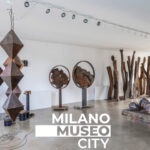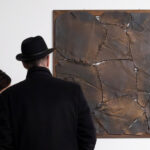Monumental sculpture on permanent display around the world
Maria Cristina Carlini’s work is present on three continents: Europe (Rome, Milan, Cosenza, Loreto, Reggio Calabria), North America (Denver, Miami) and Asia (Beijing, Shanghai, Jinan, Rongcheng – Shandong, Tianjin).
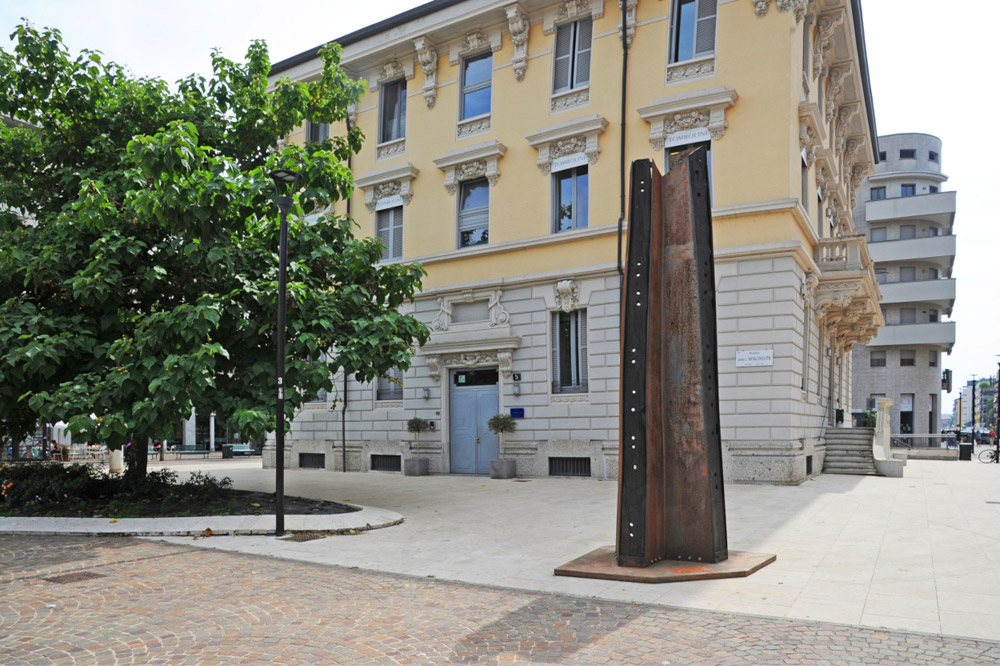
2024
Milano, Piazza Enrico Berlinguer
Obelisco, 2015, reclaimed wood, corten steel, cm 420 x 230 x 170
In 2024, Maria Cristina Carlini donated her monumental sculpture Obelisco (Obelisk) to the city of Milan. Its permanent installation in Piazza Berlinguer was overseen by curator Flaminio Gualdoni. Created in 2015, the sculpture has a strong vertical thrust and unites two very different materials: reclaimed wood and Corten steel, which together establish a profound dialogue and a harmonious aesthetic balance. The link to the past is represented by the reference to the tradition of the obelisk as an architectural element and by the theme of memory, both of which are essential, distinguishing elements in the sculptor’s artistic research. However, this work is also an invitation to consider the present and the future.
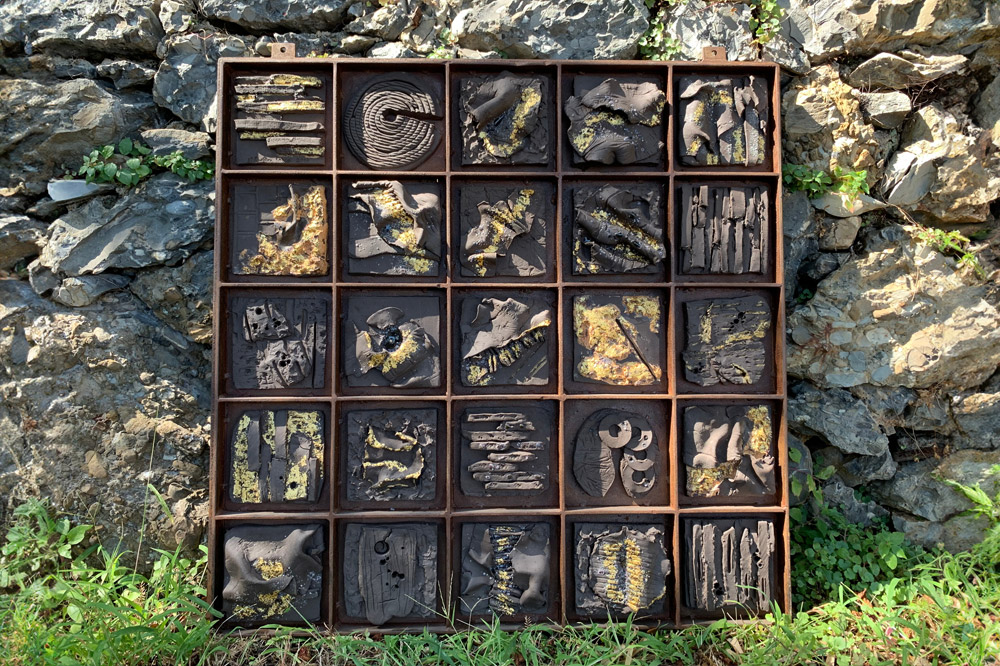
2019
Portofino, Museo del Parco di Portofino Centro Internazionale di Scultura all’aperto
Impronte, 2018, 25 elements in stoneware, iron, gold leaf, cm 95 x 94 x 5
With 25 varying panels united to form a single composition in stoneware and gold leaf on an iron core, the diverse forms and signs of Impronte (Imprints) evoke the experiences and universal memories that unite the past and present. The sculpture was created in 2018, and in 2019 it was installed among other works at the Museo del Parco di Portofino International Outdoor Sculpture Centre, whose notable collection hosts the work of numerous international artists. The clay tiles are imprinted with fossil-like images that allude to an ancestral way which is revitalised through recollections and memory. Elements that recall the earth and a respect for nature are constantly present in Maria Cristina Carlini’s art.
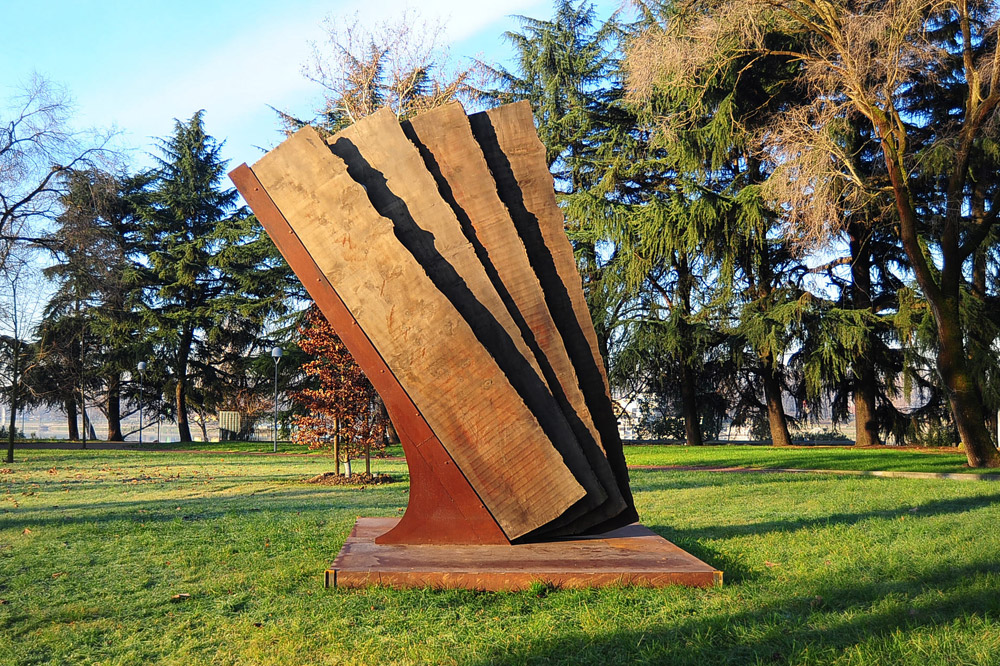
2015
Milano, Parco dell’Arte all’Idroscalo
Vento, 2013, reclaimed wood, corten steel, cm 430 x 300 x 100
At the proposal of critic and curator Martina Corgnati, in 2015, Vento (Wind), composed of reclaimed wood and Corten steel, became part of the sculptural itinerary at the Parco dell’Arte in Milan, which extends for approximately one kilometre along the east bank of the Parco Idroscalo. The inauguration of the work in its permanent position was included among Milan’s Expo 2015 events. The sculpture incorporates the exposition’s themes: first and foremost, the protection of the environment and eco-sustainability. Vento creates a profound dialogue with nature and the surrounding environment, and its fan-like structure evokes the movement generated by the wind.
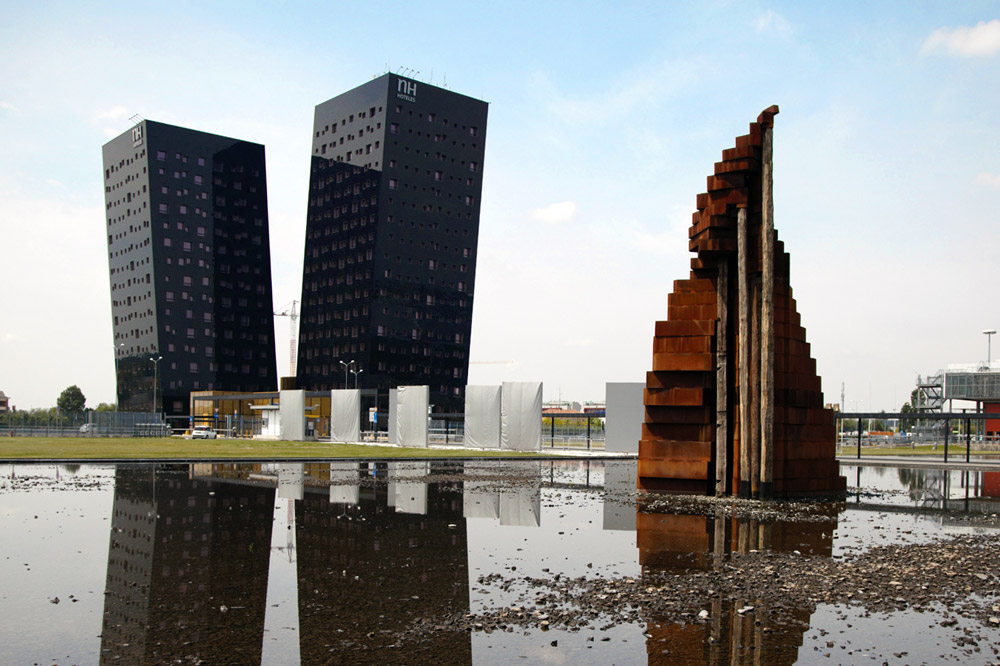
2014
Rho, Milano, Fieramilano Porta Sud
La nuova città che sale, 2014, corten steel, wood, m h 10
On the occasion of EXPO 2015, the Fiera Milano Rho welcomed the permanent installation of Maria Cristina Carlini’s monumental sculpture La nuova città che sale (The New City Rising), first presented by Philippe Daverio at the 2014 Milan Triennale. The 10-metre high work in corten steel and wood stands on the stretch of water at the Porta Sud main entrance to the exhibition centre, adjacent to the Congress Centre. The twisting, asymmetrical form of this original stairway, together with its verticality and materials, enclose symbols and meanings that reflect the themes of EXPO 2015, namely the search for a new balance between humanity, nature and technology, and the exploration of available resources and eco-sustainability. The numerous steps that decrease in size as they rise to infinity mark the ascent towards improvement and a sort of bridge that connects past, present and future.
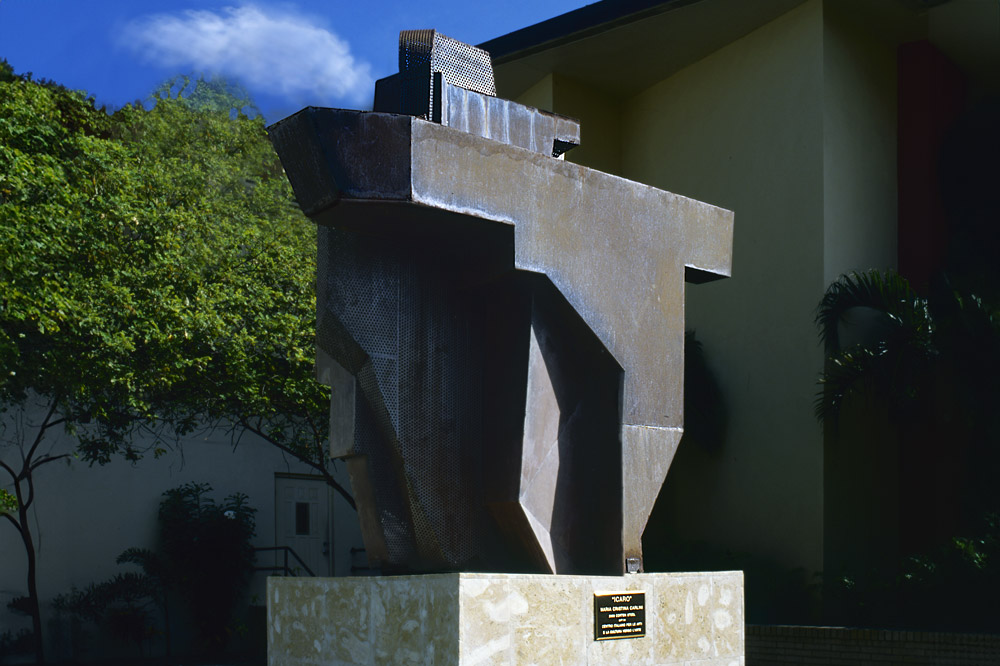
2011
Miami, Corpus Christi Catholic Church – Sculpture Park
Icaro, 2010, corten steel, cm 280 x 250 x 130
Icaro (Icarus), a work from 2010, invokes in name and form the famous mythological character. Unlike this ancient myth’s original narrative, in which the wings are modelled from wax, Carlini has reinterpreted them in perforated Corten steel, which conveys an image of lightness in contrast to the rest of the body. In 2010 the work was exhibited at Rocky Mountain College of Art + Design in Denver and also at Coral Gables Museum in Miami. In 2011 it was permanently installed to mark the inauguration of the Sculpture Park located near Corpus Christi Church in Miami.
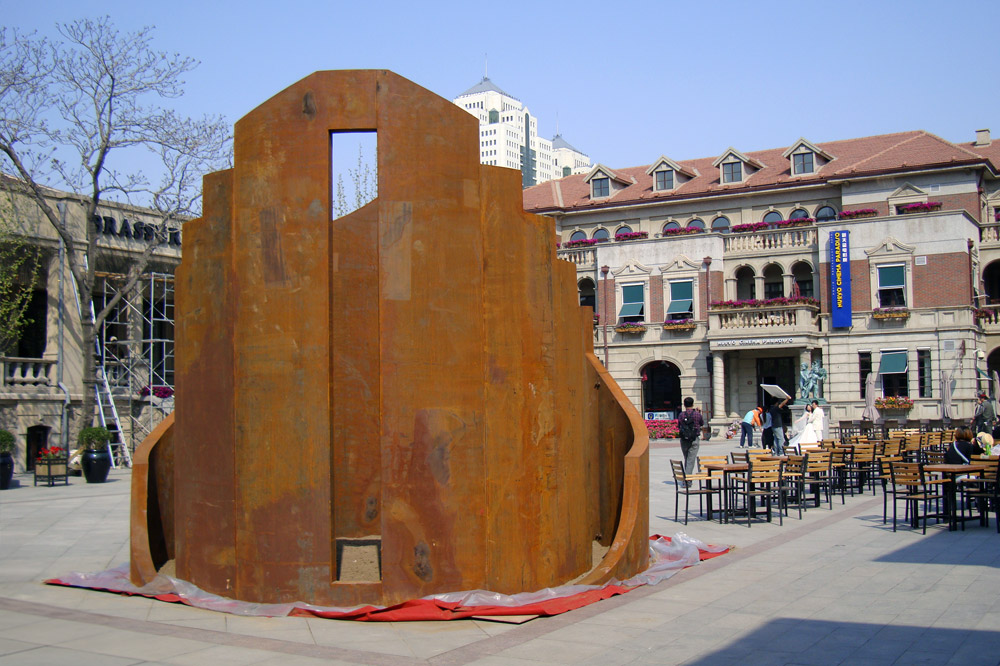
2011
Rongcheng – Shandong
Fortezza II, 2010, corten steel, cm h 440 x Ø 500
Fortezza II (Fortress II), constructed in Corten steel in 2010, was permanently installed in Rocheng – Shandong in 2011. The sculpture consists of two parts which together form a circular shape characterised by the strong balance between alternating lines and curves, and by openings that enable an interaction between inside and outside, a typical feature of many of Carlini’s works and one which contributes to their sense of dynamism despite their immense dimensions. Viewers are emotionally and visually drawn to relate to this space and to confront a dimension of the past that evokes a universal memory.
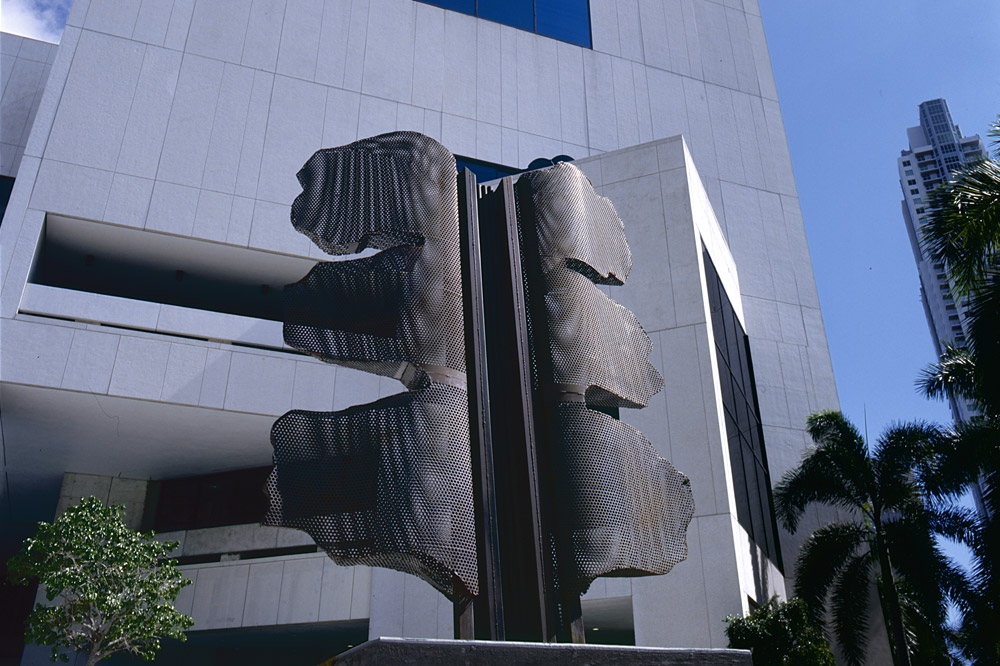
2010
Miami, Dade College
La Vittoria di Samotracia, 2010, corten steel, cm 280 x 250 x 130
La Vittoria di Samotracia (The Victory of Samothrace), with its large unfurled wings almost three metres in height, is a reference to the myth of the goddess Nike. Perforated Corten steel and the sculpture’s oblique position – an allusion to the instant before flight – provide a sense of lightness that heightens the grandeur of the work. The sculpture was exhibited together with other works at Sculpt Miami 2010, a collateral event of Art Basel Miami Beach, during which all the sculptures were displayed in the outdoor areas of the city’s prominent cultural establishments. After the closure of the event, La Vittoria di Samotracia was permanently installed in the renowned Miami Dade College, the largest university in Florida, which celebrated its 50th anniversary in 2010.
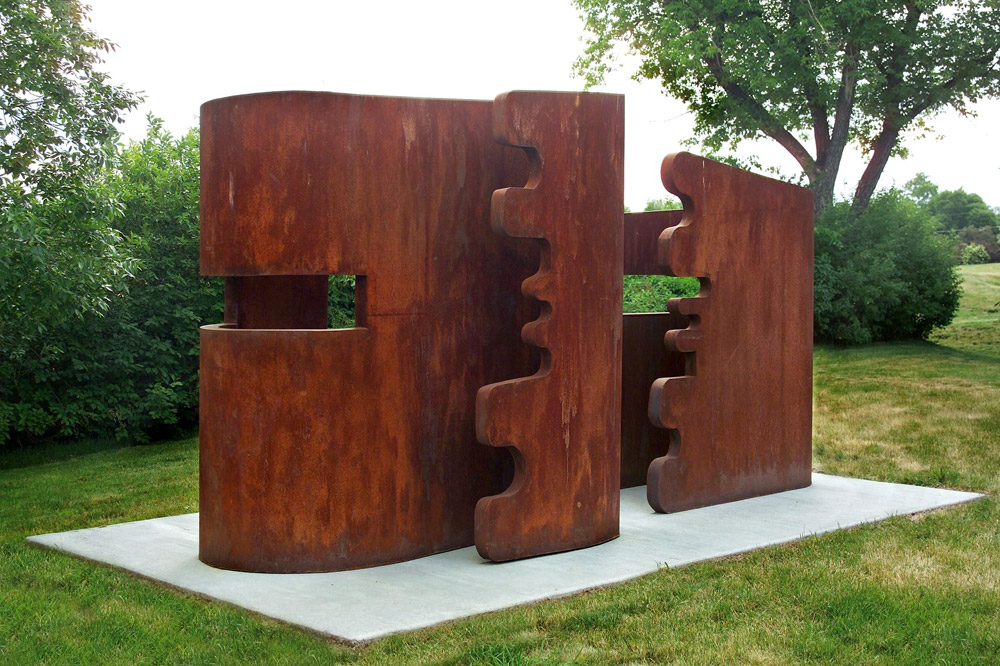
2010
Denver, Rocky Mountain College of Art + Design
Out & Inside, 2005, corten steel, cm 200 x 185 x 400
Out & Inside constructed from corten steel, is a further example of the artist’s monumental sculptures that now enhance outdoor spaces in locations dedicated to the diffusion of culture. The United States in particular has often invited Carlini to exhibit her work and to hold courses in prestigious educational institutions and colleges, in this case the Rocky Mountain College of Art + Design in Denver. In fact, the message of Out & Inside, a work characterised by its soft lines, is to both welcome the world and to open ourselves to it.
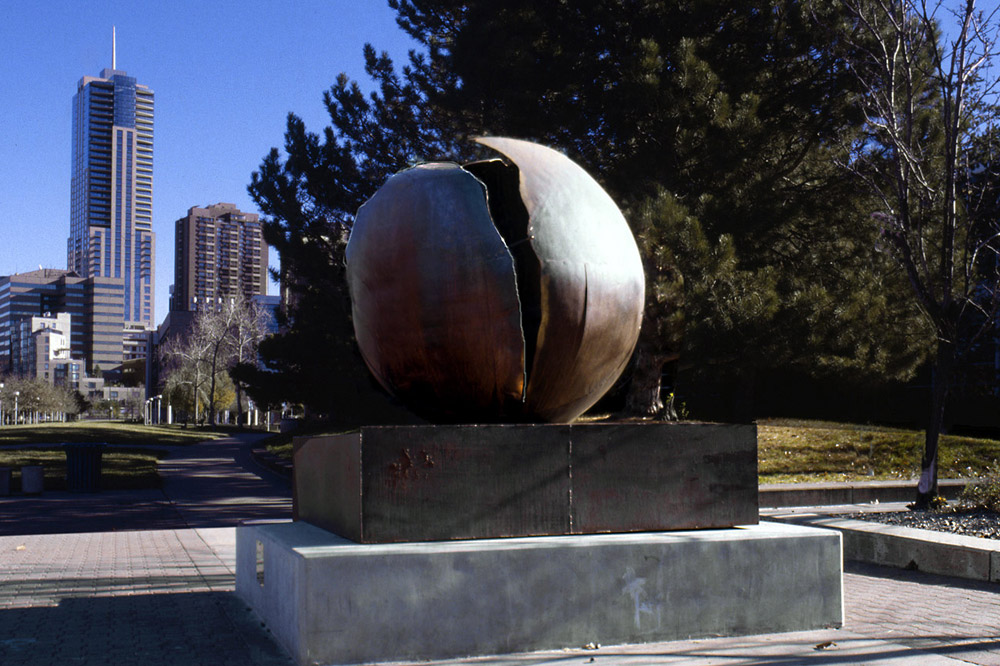
2010
Denver, Auraria Campus
Madre, 2009, corten steel, cm 170 x 200 x 200
In 2010, Maria Cristina Carlini’s art arrived in the United States. The sculpture Madre (Mother) was permanently installed in a spacious outdoor location at the Auraria Campus, one of the most prestigious university complexes in Denver. The spherical work in Corten steel is a tribute to Mother Nature, to which Maria Cristina Carlini has always been deeply attached. The earth safeguards our origins and memory, fundamental themes that have been consistently present throughout the sculptor’s career.
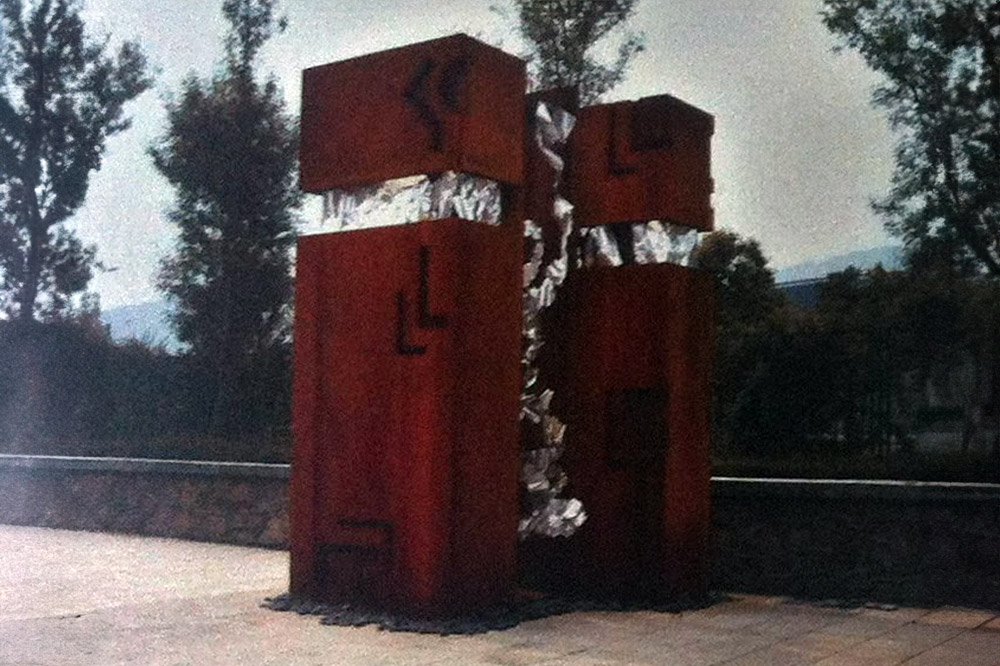
2010
Jinan, Shandong University of Art and Design
Legami III, corten steel, lead, cm 350 x 250 x 460
During the course of various exhibitions in China, in 2010 the Shandong University of Art and Design awarded Maria Cristina Carlini an honour for her art and for the promotion of Italian culture in China. To mark the event, a solo indoor and outdoor exhibition was organised at the modern university complex, where the monumental sculpture Legami III (Links III) was installed and remains on permanent display. The work comprises two monolithic Corten steel parallelepipeds joined by a layer of ductile, flexible lead, an allusion to the complex dimension of human relationships.
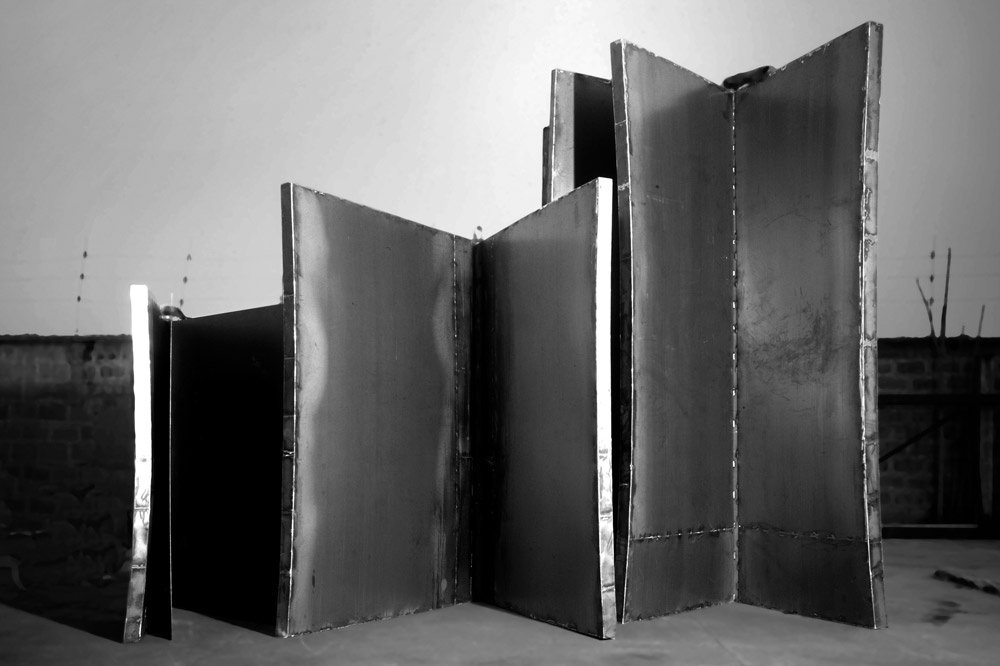
2010
Tianjin, Istituto Italiano di Cultura
Letteratura II, 2010, corten steel, cm 300 x 400 x 150
Letteratura II (Literature II), constructed from Corten steel, is an homage to the great Italian and Chinese cultures. Maria Cristina Carlini’s monumental sculpture represents, in this respect, an ideal bridge. In 2010 it was permanently installed in the Italian quarter of Tianjin, a city twinned with Lombardy. This area of Tianjin, built in the first half of the 20th century, is the only example of neo-Renaissance architecture in China. The architects who constructed the various buildings were inspired by the Art Nouveau and Art Deco styles that characterised the the buildings in Versilia. The work is located a few metres from the headquarters of the Italian Cultural Institute.
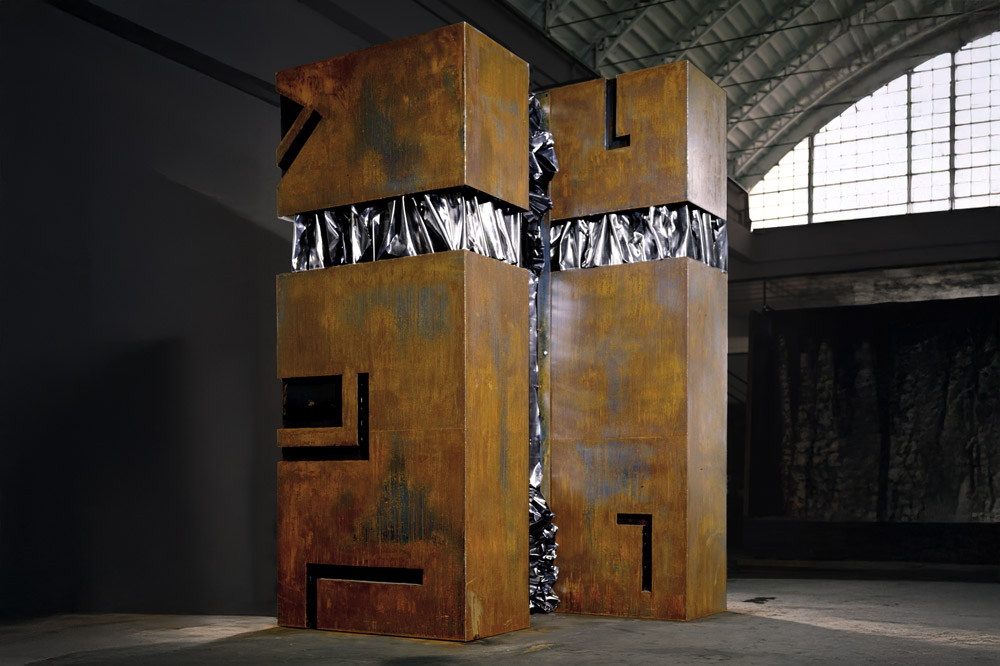
2010
Shanghai, Sculpture Park
Legami II, 2010, corten steel, cm 350 x 250 x 460
This imposing work, composed of Corten steel, was specifically conceived for Expo 2010 and is installed with other monumental works by the artist in the famous People’s Square in Shanghai. The square is the largest in the city as well as its political and cultural epicentre. It is also the site of an immense park and various prestigious buildings, among them the People’s Palace (the municipal seat of government), the Urban Design Exhibition Centre and the Grand Theatre. Legami II (Links II) subsequently became one of the works on permanent display at the Sculpture Park.
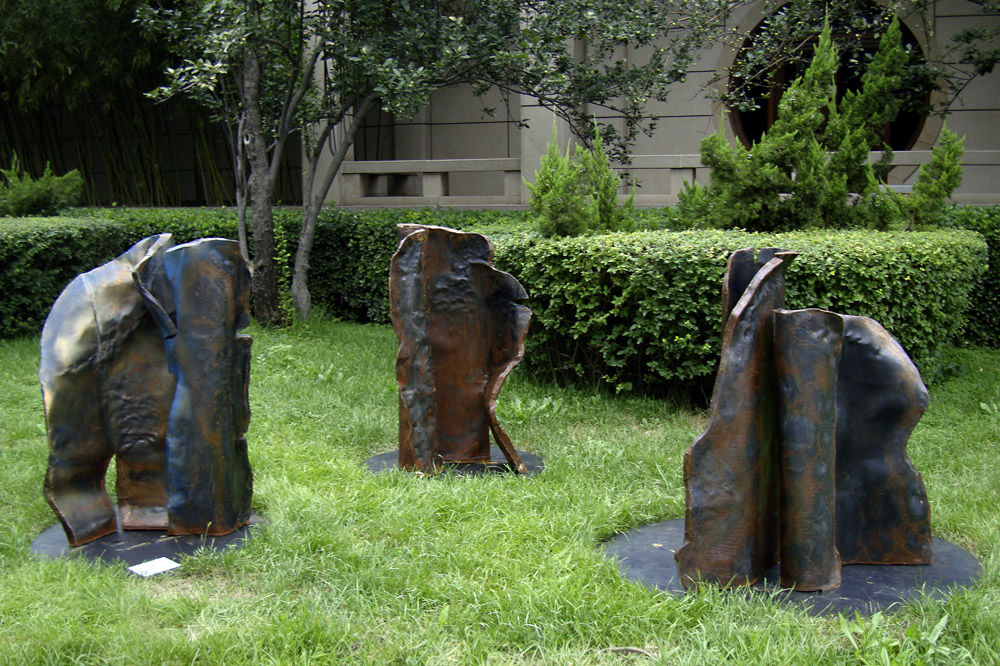
2010
Pechino, NAMOC – National Art Museum of China
Danzatrici, 2010, 3 elements, corten steel, cm h 120
In 2010 Maria Cristina Carlini took part in the 4th Beijing International Art Biennial with Le Danzatrici (The Dancers). Created especially for the occasion. The work consists of three elements in Corten steel and is on permanent display at the renowned National Art Museum of China, NAMOC. The theme of the event concerned the relationship between humans and the environment, which the artist interpreted with sinuously curved sculptures in a dance that follows the beat of the earth, a sound and a call that should always be respected.
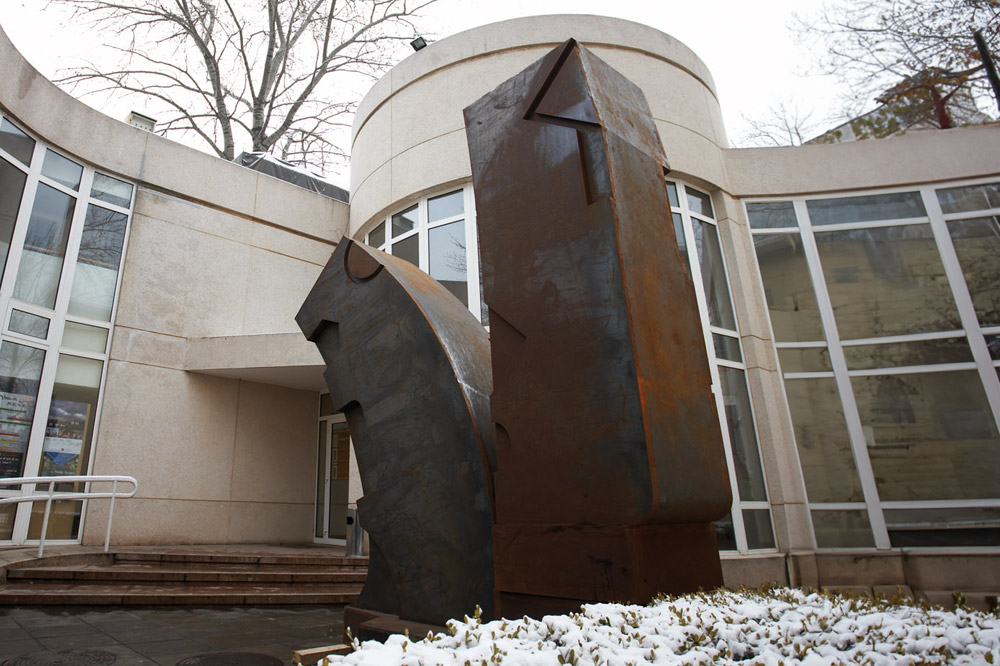
2010
Pechino, Ambasciata Italiana in Cina
Viandanti II, 2010, corten steel, cm 400 x 250 x 140
Viandanti II (Wayfarers II), constructed from Corten steel, was permanently installed in 2010 at the Italian Embassy in Beijing during celebrations to mark the 40th anniversary of diplomatic relations between Italy and China, an agreement signed in the Chinese capital in the 1970s. Following this inaugural event, Maria Cristina Carlini was invited to exhibit several monumental sculptures at the 2010 Shanghai Expo and at the exhibition organised for International Women’s Day.
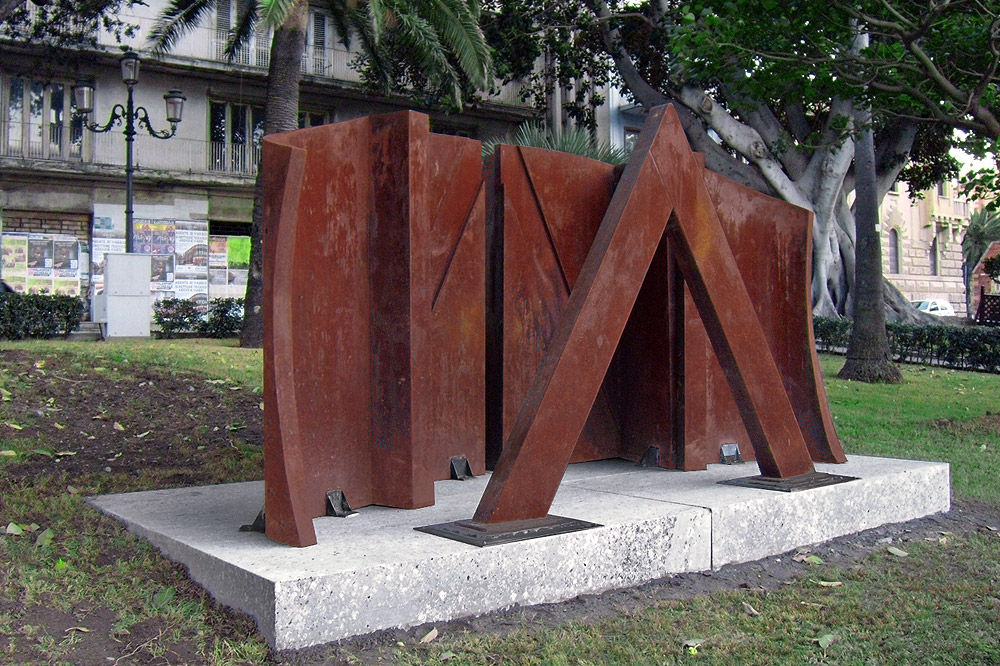
2010
Reggio Calabria, Lungomare Italo Falcomatà
Monumento al Mediterraneo, 2006, stoneware, iron oxide, cm h 190 x 405 x 200
An exceptional permanent location is reserved for Monumento al Mediterraneo (Monument to the Mediterranean), a large-scale sculpture previewed to the press at the Palazzo Reale in Milan. The work adorns the evocative Italo Falcomatà promenade in Reggio Calabria, close to Villa Genoese Zerbi, which Gabriele D’Annunzio described as ‘the most beautiful kilometre in Italy’. The stoneware and iron oxide sculpture is intended as a tribute to the sea it is named for and the beauty associated with it. It was included in a 2009 solo exhibition by Maria Cristina Carlini, promoted by M.I.B.A.C. and curated by Frèdèrique Malaval at the prestigious Aragonese Castle.
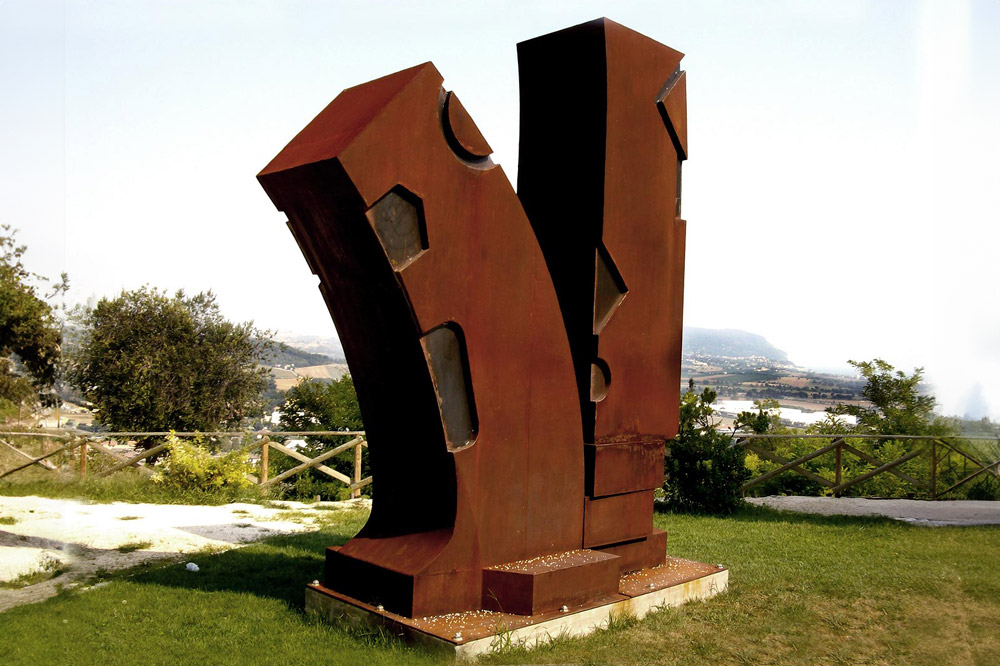
2009
Loreto (Ancona), Giardini di Porta Marina
Pellegrini, 2009, corten steel, cm h 400 x 250 x 140
The monumental scuplture Pellegrini (Pilgrims), constructed from corten steel, is a site-specific work created for the Giardini di Porta Marina in Loreto, where it has been on permanent display since 2009. Included in a solo exhibition of works placed at strategic points across the city, Pellegrini is Carlini’s homage to the location of the house of Our Lady of Loreto and to the pilgrims from all over the world who visit it. The exhibition formed part of an event entitled the Sculpture Itinerary, conceived and curated by Carlo Franza and promoted by the city of Loreto with the aim of creating an open-air museum of international contemporary sculpture that would consolidate the link between symbolism past and present, a recurring theme in the artist’s work.
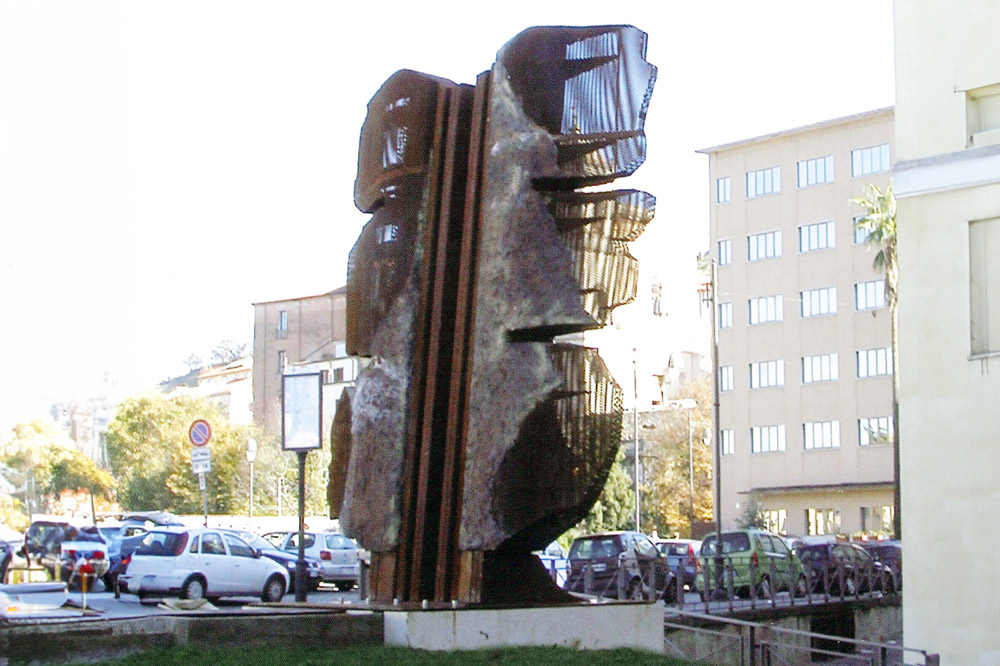
2008
Cosenza, Piazza dei Valdesi
La Vittoria di Samotracia, 2008, corten steel, resin, cm 280 x 200 x 70
La Vittoria di Samotracia (The Victory of Samothrace) constructed from perforated Corten steel and resin, was permanently installed in the Piazza dei Valdesi, Cosenza, in 2008, in conjunction with the artist’s solo exhibition at the city’s National Library. The sculpture forms part of an open-air contemporary art itinerary and is situated in an area designed as an architectural point of connection between past and present, an intersection between natural landscape and urban spaces, where it is perfectly integrated in terms of structure and significance.
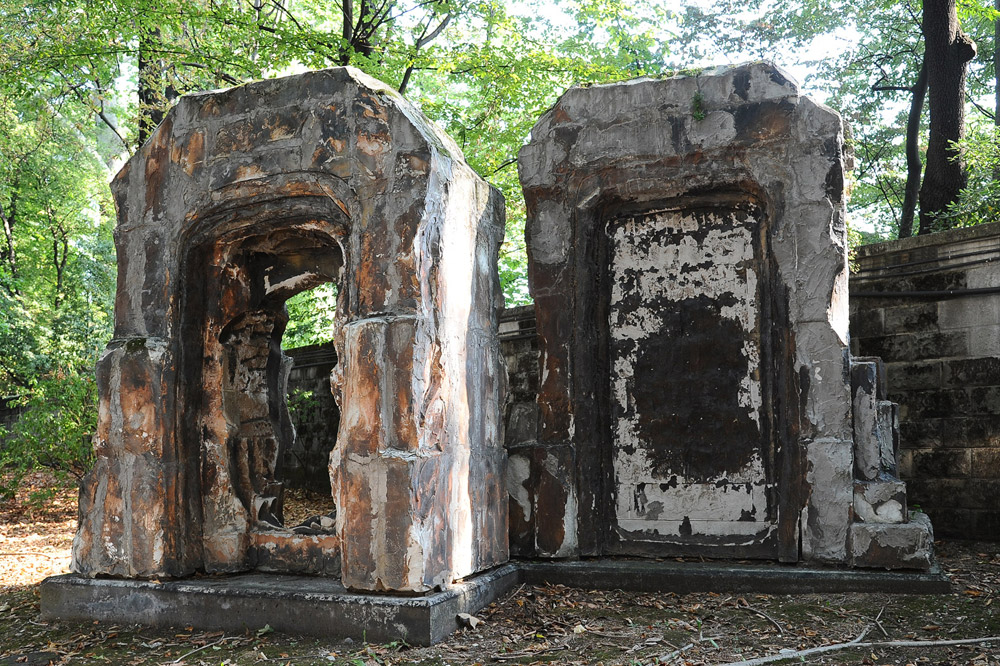
2007
Milano, Corte dei Conti
La porta della giustizia, 2007, iron, resin-coated gasbeton, cm 420 x 225 x 285
The monolithic La Porta della Giustizia (The Door of Justice), composed of iron and resin-coated gasbeton, is permanently installed in the internal gardens of the Corte dei Conti in Milan. The sculpture features a slightly staggered double portal, one of which has a central cavity whereas the other is closed. This interplay of openings and closures represents a contemporary reinterpretation of the iconography of justice, and it embodies multiple cultural and symbolic references to the concept of the ‘door’, a liminal and metaphorical place of passage. To remedy the adverse effects of atmospheric agents, in 2020 the sculpture was restored to its original appearance.
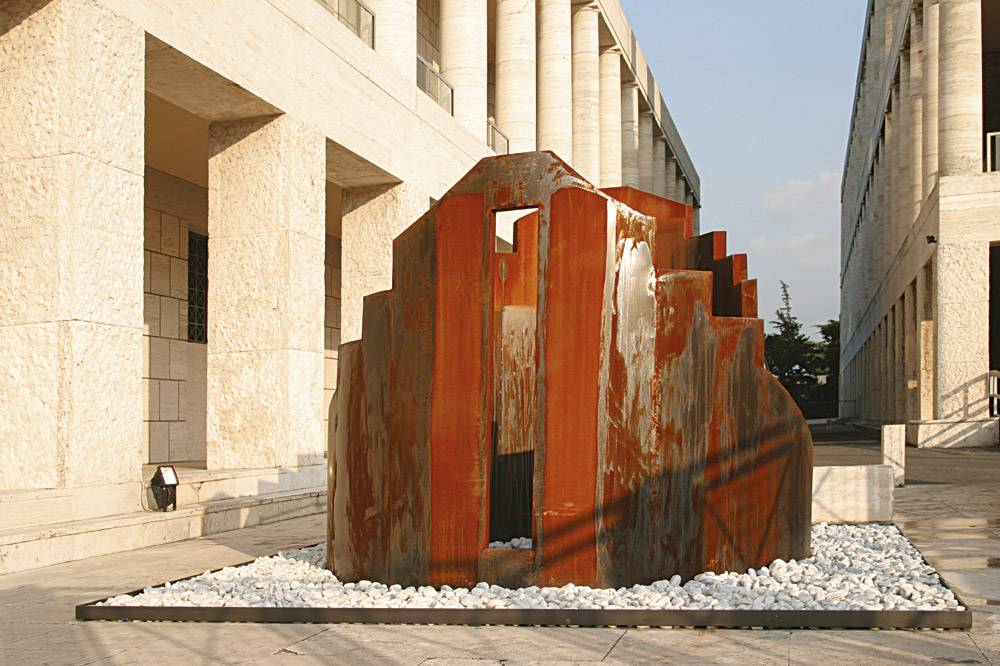
2006
Roma, Archivio Centrale dello Stato
Fortezza, 2006, iron, cm h 220 x Ø 250
Fortezza (Fortress) was installed in 2006 in the forecourt of the Archivio Centrale di Stato di Roma Eur on the occasion of the artist’s solo exhibition Terre, sponsored by the Ministry for Cultural Heritage and Activities and exhibited in the rooms of the Archivio Centrale. The work’s imposing appearance and rigorous design represents a vision of the contemporary world in dialogue with the challenges arising from the impoverishment of resources. The sculpture’s synthesis of functional and expressive elements, voids and solids, integrates harmoniously with the surrounding architecture as a symbol of the defence of knowledge and culture.
